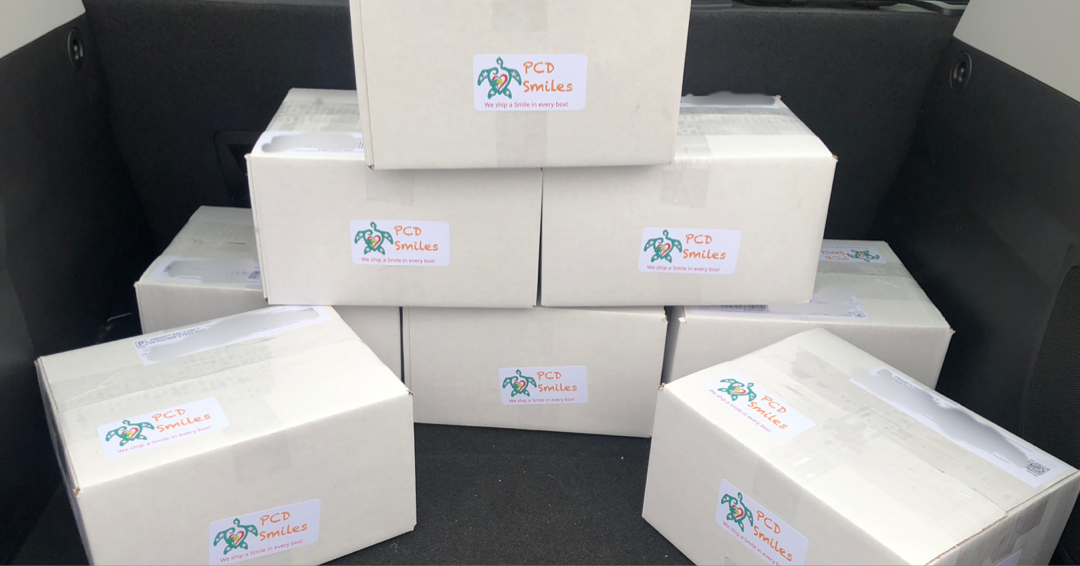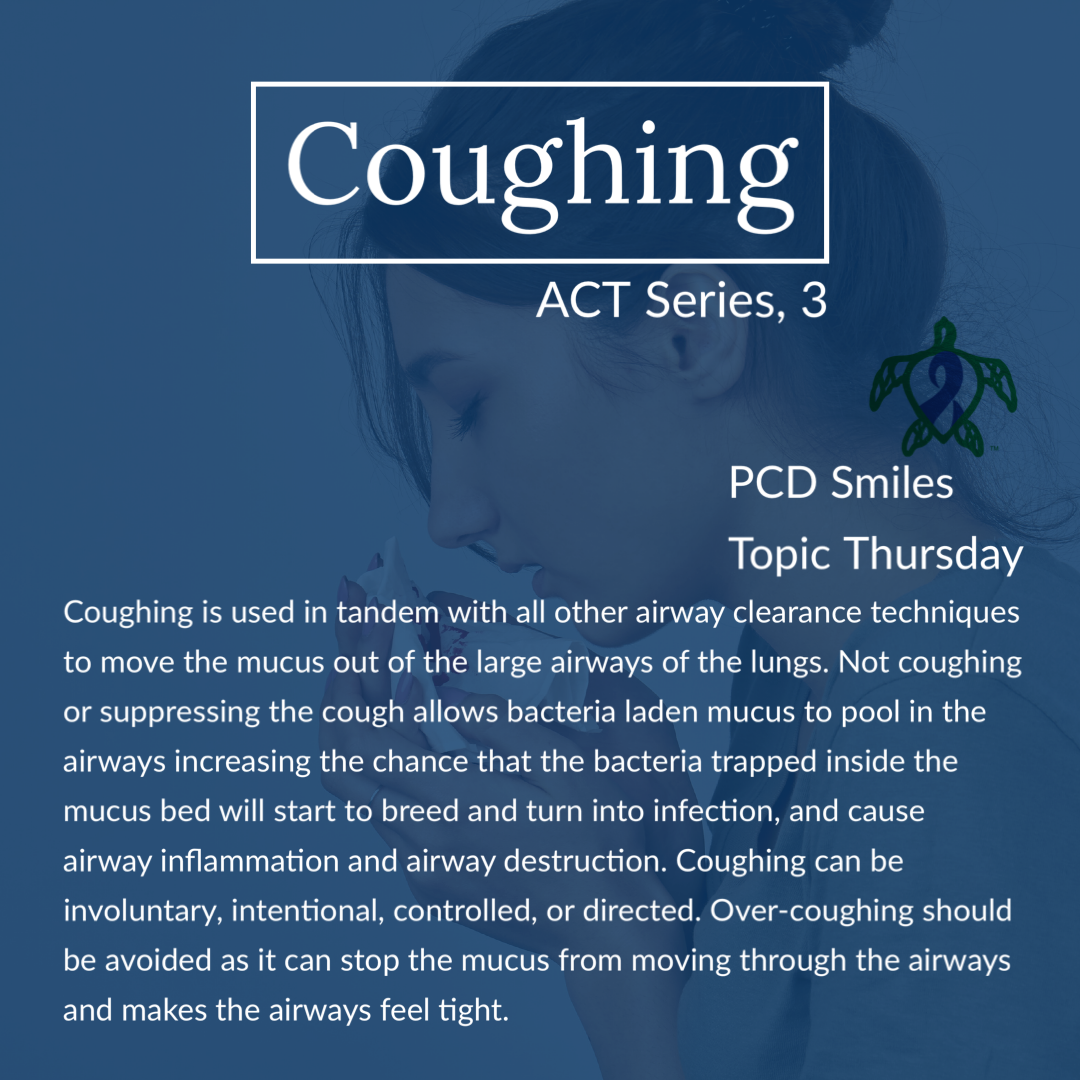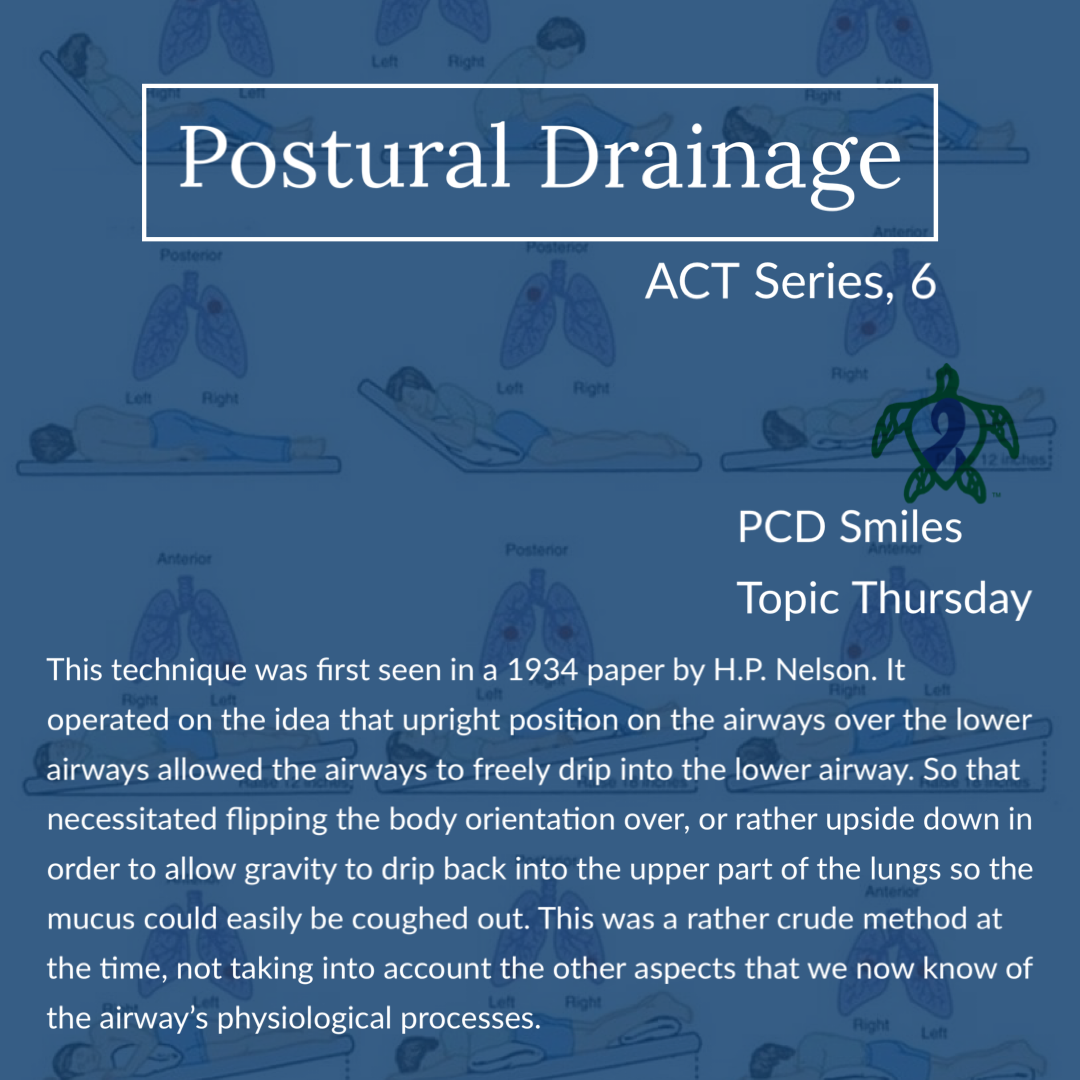As we continue our deep dive into airway clearance our first, most basic, and by far the easiest airway clearance technique is coughing. Coughing is used in tandem with all other airway clearance techniques to move the mucus out of the large airways of the lungs. Not coughing or suppressing the cough allows bacteria laden mucus to pool in the airways increasing the chance that the bacteria trapped inside the mucus bed will start to breed and turn into infection, and cause airway inflammation and airway destruction. Coughing can be involuntary, intentional, controlled, or directed. Over-coughing should be avoided as it can stop the mucus from moving through the airways and makes the airways feel tight. Staying hydrated is important for any form of airway clearance natural, artificial, or therapeutic because dehydration dries out the secretions/mucus in the airways which can make the mucus extra thick and harder to shear off the airways walls using any type of airway clearance. Intentionally coughing to clear the throat and the exit of the mucociliary escalator prior to performing any other airway clearance techniques including controlled or directed coughing is important to make sure the airway clearance session is productive. It’s important to note that coughing alone will not clear secretions/mucus the have slipped into the small airways (the alveoli), more aggressive airway clearance techniques are required to get these secretions out of the smaller airways of the lungs.
Involuntary coughing is the most basic of coughing for everyone on the planet. Just as the name implies, the coughing isn’t intentional and just happens, hence involuntary. As discussed before in a previous ACT series cough clearance is a backup part of the body’s natural ability to clear it’s own airways. The cough consists of four parts; irritation, inspiration, compression, and expulsion. Each part is essential to the body's cough clearance to move the particle, debris, and bacteria filled mucus out of the larger airways. Involuntary coughing does mostly rely in part on properly functioning cilia to perform it’s natural bodily function. In people with primary ciliary dyskinesia (PCD) their body’s natural cough clearance is greatly affected. And until as recent as five years ago when research proved otherwise, everyone in the medical and research field touted that the body’s natural cough clearance was unaffected in PCD and therefore coughing alone was enough to compensate for the lack of proper ciliary function for those with PCD. While suppressing cough is not recommended in PCD due to the chance of turning stuck mucus into infections, increasing airway inflammation and possible airway destruction sometimes it is necessary with an involuntary cough. A constant, nonproductive involuntary cough can signal a change in airway status, signal a PCD exacerbation, can impede the movement of mucus, and tire out the person to the point of exhaustion making medical intervention very important. Excessive nonproductive involuntary coughing should be reported to your medical team for evaluation as it can signal an underlying health condition that requires medical attention.
Intentional coughing is the next most basic coughing that everyone on the planet uses. Basically you feel irritation of some sort so you cough to clear it. Same as involuntary coughing, intentional coughing relies somewhat on properly functioning cilia to move the mucus through the airways to the end of the mucociliary escalator and into the throat to be able to expel the mucus through coughing. Hydration is important here as well so the mucus is thin and not dehydrated and sticky. And over-coughing intentionally also has the same effect as it does in involuntary coughing. A patient who is worn out from coughing can affect the effectiveness of intentional coughing and that can become a medical emergency in its own right. As stated previously, intentionally coughing to clear the throat and the exit of the mucociliary escalator prior to performing any other airway clearance techniques including controlled or directed coughing is important to make sure the airway clearance session is productive.
Controlled coughing or breathing exercises can help control coughing and keep the person from tiring out, make coughing productive or rather more productive, alleviate breathlessness and chest tightness, and have a natural bronchodilation affect on the airways. That last part is why there appears to be a whole lot of confusion amongst patients, clinicians, researchers, and well everyone concerning exercise as an airway clearance technique. Opening the airways and relaxing the airways is an important step in performing any airway clearance technique so that the mucus can move without restriction. Exercise has been shown in studies to have a better bronchodilator effect on airways in a person affected with PCD than pharmaceutical bronchodilators. Basically exercise opens airways to allow the mucus to move better and without triggering bronchspasms. Breathing exercises like deep breathing allows air to sink deeper into the lungs where it can get behind the mucus, giving the person more force to shear the mucus from the airway walls on exhale; basically a deep cough. To do this take a few normal breaths first, then take a deep breath and hold it for two to three seconds, and finally use your stomach muscles to forcefully exhale all the air from your lungs in a deep cough. This should move the mucus in your airways up and allow you to spit it into a tissue making your cough more productive. Repeat three time and then rest to prevent you from tiring out. A tired out respiratory patient from over-coughing will move less mucus than a rested patient. Preventing over-coughing will alleviate breathlessness and chest tightness. Breathing exercises in general can help a patient discover that they can still breathe while exercising, give them confidence that they are still getting air when stressing their body during physical activity like coughing, and open their airways with a bronchodilator like effect. This can go along way to easing the mental and emotional aspects of a period of breathlessness, and improving the patient’s perception of their quality of life.
And lastly directed coughing should be used in conjunction with every other artificial or therapeutic airway clearance technique. Otherwise the patient is not getting the secretions/mucus up and out of their lungs, this is especially true in PCD where ciliary function is or is almost nonexistent. You’ve probably heard of this as “huff coughing”. Huff coughing is also a great way to help produce a sputum sample for laboratory testing. Huff coughing also known as huffing can be done a few different ways depending on which region, country, or even local medical team that you talk with. It seems that there is no hard and fast one specific way that huff coughs are preformed. The first most basic way to do a huff cough is kind of reminiscent of fogging up glass or your glasses to clean them, like fogging up a window. It’s similar to coughing but not as forceful, and will help allow the air to separate the mucus from the airway walls and move it to the throat where you can cough it out. To do this take a few normal breaths in though your nose and out through your mouth, next breathe in through your nose and hold it (this allows the air to separate the mucus from the airway walls), the forcefully exhale through your mouth in there equal breaths while pulling your stomach muscles inward while making a huff sound with the back of your throat. Repeat this entire process three times. Another popular way to huff cough is to sit up straight with chin tilted slightly up and mouth open, take a slow deep breath to fill lungs about three quarters full, then hold your breath for two or three seconds, next exhale forcefully, but slowly, in a continuous exhalation to move mucus within the airways, repeat this process two more times; then follow with one strong cough to clear mucus from the throat or mucociliary escalator exit. Using a cycle of four to five huff coughs as part of your other airway clearance techniques or at the very end of your other clearance techniques is extremely important for effective airway clearance. It’s also an effective way to cough out the mucus that a patient was able to move during airway clearance techniques without tiring them out further than they already are from airway clearance therapy.
While not necessarily a part of coughing, splitting maybe necessary to effectively using coughing as an airway clearance technique. This is especially true for sore chest muscles due to coughing, surgical procedures, broken ribs or other injury, and or even airway clearance therapy itself. This involves grabbing a pillow, stuffed animal, or even small towel and rolling it up and holding it against your chest with your arms as you cough. You can even hold it over the injury or even your chest port, if you have one. Unfortunately; some discomfort from time to time is to be expected. However you should notify your team if the soreness persists or if soreness prevents you from doing any type of airway clearance at all.
Although evidence whether artificial or therapeutic airway clearance therapy is effective or even which type of airway clearance therapy is effective for patients with primary ciliary dyskinesia (PCD) is lacking. The over all consensus is that the body’s natural airway clearance is impaired in patients with PCD. When the body’s natural ability to clear it's airways is impaired in anyway it leads to retained secretions (mucus) that then becomes a breeding ground for infections. These retained secretions and later infections can damage any part of the body’s natural airway clearance. Improperly applying artificial or therapeutic airway clearance techniques can also damage any part of the body’s natural airway clearance as well. Learning the ins and outs of artificial or therapeutic airway clearance techniques is essential to doing life with primary ciliary dyskinesia. We hope that you join us next week for part four of our series on airway clearance techniques.
Be sure to join us next week for another Topic Thursday.
Join our Facebook group Turtle Talk Café today, click here.
We have several ways that you can donate to PCD Smiles;
- Visit Smile E. Turtle's Amazon Wishlist
- For more information on how you can donate, please visit our "Donation" page to check out our "Do & Don't policies.
- Or sponsor a PCD Smiles cheer package today!
- To shop for your “Official” turtle care ribbon gear today, visit PCD Style or Smile E. Cove
Thank you for your consideration!
***Please speak to your respiratory therapist or your PCD medical team before commencing any new treatment. DO NOT start using a device, or technique, on this website if you have not discussed this with your PCD team first.***














